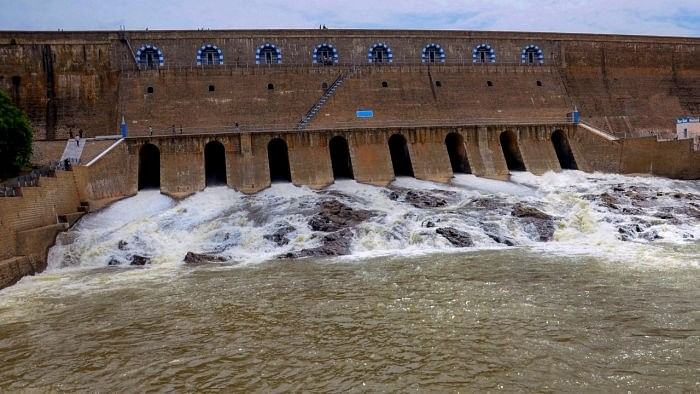
Mettur dam gates.
Credit: PTI Photo
Chennai: With the Stanley Reservoir in Mettur achieving its full reservoir level (FRL) of 120 feet for the first time in one-and-a-half years, the Tamil Nadu government on Tuesday the administration in 11 districts to be alert and move people living in low-lying areas to safety.
The high alert has been sounded because the outflow from the dam is expected to increase to about 1.25 lakh cusecs in the next few days.
The outflow from the dam gradually increased from 23,000 on Tuesday morning to 81,500 cusecs in the evening. This is the first time that the dam achieved its FRL in about 19 months – in 2022, the dam achieved FRL thrice.
After the dam achieved its FRL of 120 feet at 6 pm, the entire inflow into the dam was released into River Cauvery. The water storage stood at 92.56 tmc even as the inflow was 54,459 cusecs and outflow (23,000 cusecs) at 4 pm.
The inflow into Mettur Dam, the lifeline of lakhs of farmers in Tamil Nadu’s Cauvery Delta region, is expected to increase to about 1.25 lakh cusecs in the next few days with heavy rains continuing to pound the catchment areas in Karnataka which will lead to reservoir there releasing the excess water into the river.
The advisory has been issued to district collectors of Salem, Erode, Karur, Namakkal, Ariyalur, Tiruchirapalli, Thanjavur, Tiruvarur, Cuddalore, Mayiladuthurai, and Nagapattinam.
“District administrations are advised to adhere to safety instructions due to water release from the Stanley Reservoir in Mettur and to monitor evacuation process in low-lying areas,” the advisory said.
Officials said district collectors have also been asked to ensure that people avoid taking selfies from vulnerable points along the river. “They have also advised to tell people not to go near the river which is likely to be in spate,” a senior government official told DH.
Separately, the government has decided to release water through the east and west canals of the Mettur dam for 137 days from Tuesday. The water will help irrigate 43,443 acres in Salem, Namakkal, and Erode districts.
The Tamil Nadu government, which was accusing Karnataka of not releasing Cauvery water as per the directions of the Cauvery Water Regulatory Commission (CWRA), opened the dam for irrigation on July 28 after the water level hit the 100-mark. The dam couldn’t be opened this time on the designated date of June 12 due to low water storage.
The water released from Mettur will help farmers in the Cauvery Delta region to prepare in advance for the cultivation of samba (long-term crop) on about 18 lakh acres. The farmers were upset that water was not released for kuruvai (short-term crop) in June which is cultivated in an area of about 5 lakh acres.
Welcoming the move, P R Pandian, President of the Coordination Committee of All Farmers' Associations of Tamil Nadu, said the state government should ensure that Cauvery water reaches the tail-end areas which are in desperate need of water.
K Srikanth, an independent weather blogger, said between 21st June (when monsoon picked up pace for the 1st time in the season) and July 17 (when the peak surge started), the net inflows into Karnataka dams in the Cauvery Basin were nearly 51 TMC.
“During the same period, Mettur received a cumulative inflow of less than 4 TMC as Karnataka stockpiled water. Between July 21 and July 28, the cumulative net inflow into Karnataka dams was 67.7 TMC, while the inflow into Mettur Dam was 50.4 TMC indicating how effectively Mettur became a flood surplus reservoir in the Cauvery basin,” Srikanth said.
The increase in water level has effectively avoided a confrontation between Tamil Nadu and Karnataka which continues to fight over the sharing of Cauvery water.